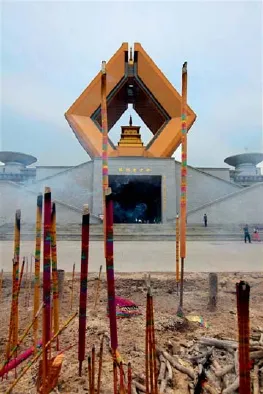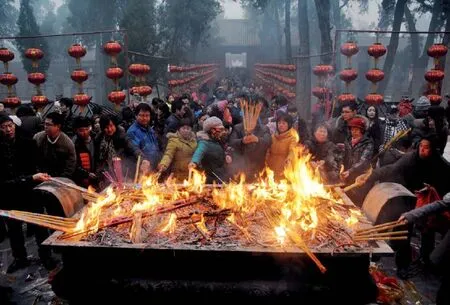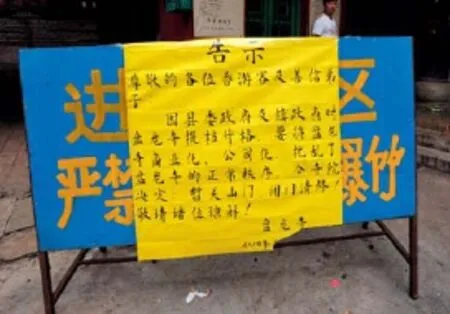THE BUSINESS OF BUDDHISM
BY GINGER HUANG (黄原竟)
THE BUSINESS OF BUDDHISM
BY GINGER HUANG (黄原竟)
Is greed prompting the downfall of Buddhism?
黄金加身,是否佛心依旧?

In October, 2014, Nyima Dorjee Rinpoche, abbot of Palden Ningye Monastery, set off on a journey to what Tibetans call “Handi”, which loosely translates into“the Han ethnic land”. He was on a sacred mission to visit Mount Wutai in Shanxi Province. China has four sacred mountains in Buddhism, but Mount Wutai is the most celebrated. It was a particularly special destination for Nyima Rinpoche because it is the “Seat of Awakening” for Manjusri, a bodhisattva of wisdom, who Nyima believes was reincarnated as his mentor. For this well-traveled, 38-year-old monk, the site is one of many pilgrimages on the quest for ultimate wisdom.
He felt a sense of accomplishment and exhilaration when he encountered the valley fi lled with monasteries. Marshalling the utmost respect, Nyima performed his sutras and carefully groomed himself before entering the mountains.
From there, things started to go horribly wrong.
In a particularly grand monastery, he saw two monks sitting with their feet resting on the chairs, “like two bosses,” he says. He asked which monastery was the most ancient; they didn’t know. He inquired about the differences between Han and Tibetan Buddhism; they didn’t know. Nyima asked if they were converted; theymerely showed Nyima their conversion certifi cates, which they kept in their chest pockets. As to the real meaning of conversion (皈依), they were clueless.
“They knew nothing!” Nyima exclaims. “Conversion is not about papers, it’s about here.” He laid his palm on his chest. “These temples are magnifi cent, but there was no Buddha, or Buddha’s Way, in them. They are hollow.”
Nyima left Mount Wutai disillusioned and saddened. “This is what happens in the Downfall Era of Buddhism.”
The Downfall Era of Buddhism (末法时代) is often cited as the reason for the ills of Buddhism in our modern times. Before he attained nirvana, Buddha predicted the downfall of his own religion in three phases, the fi rst being the fi rst thousand years of thriving, a second thousand years of refl ection on the fi rst phase, and the third millennium being the downfall.
In China, at times, it looks particularly lost. For many Chinese people, the traditional image of a Buddhist monk is someone next to a saint: thin, dignifi ed, and a trusted guide on spiritual matters—perhaps even a psychic with supernatural powers. But, most of all, they should neither have nor want money. This romanticized image causes all the more antipathy toward the modern Chinese Buddhist monks of reality.
For an ordinary pilgrim, one needs to be quite well-off to visit a monastery. Most temples charge an entrance fee, and a lot of them are high enough to bar most pilgrims from regular entry. You can fi nd a donation box by every gate of every hall. When you enter a monastery, you are usually coerced into buying a candle or putting your family name down for a ceremony, with monks offering guarantees of good luck and fortune.
Meanwhile, as China gets richer, Buddhism’s patrons give more and more generous offerings. In some wealthy monasteries, abbots can be seen driving a BMW, Audi, or even a Porsche—often gifts from wealthy patrons with now assuredly spectacular karma. Shi Yongxin (释永信), abbot of Shaolin Monastery and possibly the most well-known monk in China, is commonly called the “CEO of Shaolin” because he started over ten companies under Shaolin’s name. For some, the death of the romantic ideal has caused a loss in faith, and for many others, the perception of Buddhism has changed to one of greedy monks, expensive incense, and tourist hotspots.
If, indeed, this is the millennium of the downfall, how did it come about? Gao Xiang, a member of the Beijing Buddhist Association and a well-known Weibo celebrity for his Buddhism advocacy, believes it is the cost of the modern world. “It’s not that monasteries want themselves to be commercialized—they have to. They are forced to.” A long history of Buddhism in fl ux has led to Xiang’s view, a view many share.

A grandiose monument built by developers outside Famen Monastery

Tourists and pilgrims flock to the crowded Yonghe Monastery in Beijing to pay their respects for the New Year
Although Chinese history is littered with attempts to ban Buddhism outright, none were as thoroughly destructive as the Cultural Revolution. With the exception of a few monasteries of unsurpassed historical value, most temples were converted or turned to rubble. Before 1949, Beijing had over 700 hundred monasteries within the second ring road; now there are only 20. When the 1990s came, such problems ceased. It was the decade when Deng Xiaoping famously advocated the slogan, “Everything should be centered around economic development.” A new passion for money fi lled China with energy and anxiety, and everything that could make money was considered good. Just when Buddhism was staggering into recovery, money presented a new hurdle.
Tourism, which barely existed previously, became all the rage. Han Buddhism, especially its Chan (known in Japan as Zen) branch, has a tradition of seclusion and hermitages, keeping the practice as far away from the hurly-burly as possible with monasteries hidden in remote mountain areas. However, with these mountains developed into jingqu (景区, commercial scenic areas), monasteries are trapped in the center, with tourist buses fl ocking to their gates on newly built roads. After the Cultural Revolution, the monasteries were never really handed back to the monks. Temples fell under the jurisdiction of three government departments: the Tourism Bureau (旅游局), theLandscape and Forestry Bureau (园林局), and the Cultural Heritage Bureau (文物局). The fi rst thing those bureaus did was begin to charge entrance fees.
Abbot Haixin, vice president of Shanxi Buddhism Association, was a new monk when the news broke that Mount Wutai was going to charge a fee of 0.2 RMB in the 1980s. “We were fi lled with incredulity and anger. To make money out of Buddha! What kind of karma would that bring? Unthinkable. We fi ercely protested, but to no avail.”
Things got worse from there. Today, fees for some Chinese temples and monasteries can be prohibitively high for some, leaving embittered pilgrims. The entrance fee to Mount Wutai in Shanxi Province is 238 RMB, Shaolin Monastery in Henan Province charges 100 RMB, and Nanshan Monastery in Hainan Province costs 170 RMB, to name just a few.
While most blame the greedy monasteries, few are aware of the fact that most monks and nuns are against it and have petitioned to lift the fees at every National Buddhist Convention. Shi Yongxin has been petitioning the central government to lift the fee for over ten years because “it blocks the over 1,000-year-old pilgrimage path and bars pilgrims”. He has had no success. Seventy percent of the Shaolin Monastery’s fees go to the local government and the developer, but to be fair, the city that hosts Shaolin Monastery is struggling fi nancially. The ten million RMB annual revenue from Shaolin is simply too much to give up. Similarly, in 2014, seven monasteries in Jizushan Mountain, Yunnan Province collectively closed their gates to visitors in protest against the tourism developer’s intention to charge an entrance fee. Thanks to the media attention, they succeeded.
“If the entrance fee is lifted, who will suffer most?” Gao Xiang points out. “Not the monasteries. Monasteries will only be better if these fees are removed. It’s these three government sectors who have benefi ted from it the most.”
“It’s not about money, it’s about people’s hearts,” says Abbot Haixin, frowning and shaking his head anxiously. “It is giving out one message: if you are poor, you are not allowed to pay your homage to Buddha. It is an unwritten insult to those who cannot afford it. It’s no longer about 238 RMB, but about discrimination and disrespecting people.”
The abbot, still shaking his head, continues: “Did the government build the mountain? Did it build the monastery? If not, no one has a right to charge a fee. We have focused so much on economic development that we are ignoring spiritual and religious things. Buddhism is supposed to save people’s hearts, but look what it has become.”
The entrance fees, however, are not even the biggest problem. Developers and other stakeholders have also discovered that the entrance fees represent only a fraction of the profi ts monasteries can earn. Xing Yijiu (邢益就) is the founder of the Yurun Law Firm, one of China’s oldest law fi rms dealing largely with cases involving Buddhism. “If a monastery is located in a city, it will bring up theprice of the real estate around it. If it’s built in the mountains, it will bring revenue for the restaurants and hotels around it.” This model has become so popular and profi table that the saying among developers goes: “To get rich, build a temple fi rst.”

A sign from Panlong Monastery on Jizushan Mountain saying that they have closed their monastery in protest of their developer's commercialization.

A monk from Xingjiao Monastery trying to drum up media support to keep his fellow monks in their home
To get the money it takes to build a new “Buddhist Culture Scenic Area” (佛教文化景区), the local government usually sets up a“cultural investment company” fi rst. “Its board members are usually civil servants, but the funds are raised from various sources—the government, private enterprises, business loans, and sometimes by selling shares,” says Xing.
Then, things get complicated. “The nature of capital is that it has to turn a profi t on a product. That means it has to make Buddhism into a product to sell,” Xing says. Developers and pilgrims have both grown more sophisticated. Profi t motives like entrance fees, incense, beads,and fortune-telling are losing their appeal. The new trend is ceremonies to target tourists.
“The developers intuitively grasped the most benefi cial character of Buddhism: there are a lot of Buddhas and bodhisattvas, and according to tradition, a ceremony should be held on each of their birthdays,” Xing explains. “Nowadays the traditional procedures for these rituals have been made into an intricatelydesigned money trap, and developers are using more manipulative tactics. For example, you have to pay for a seat in the ceremony, the fl owers you dedicate to Buddha, and the sutra book from which you are going to chant. If you don’t pay for these, it is hinted at that something “not good” may happen because of your insincerity. Once part of it, you are lured in, step by step, and your wallet is slowly emptied.”
In such cases—often the case for most Han monasteries—monks are not monks anymore, rather they are actors. If the monks refuse to cooperate, they cannot really change anything. “The biggest confl ict between the developers and the monks is that the monks are often not cooperative,” Xing says. “I have seen so many monasteries where the developers got rid of all the monks and brought in new ones.”
The most famous incident of this kind was what became known as “Guarding Xingjiao Monastery “ (保卫兴教寺). A group of developers called Qujiangxi, notorious for their wealth and power, wanted to invest two trillion RMB into Xingjiaosi, one of Xi’an’s oldest monasteries, to develop it into a tourist site and eject the monks. The local Buddhism Association fought hard, and, having found an ally in the media, they won. But, this was a high-profi le, protracted fi ght for the prestigious Xingjiaosi; very few other monasteries can expect this result.
In reality, most monasteries in China have to yield. “I can safely conclude that, of all the monasteries in China, less than one third of them are 100 percent managed by monks,” Abbot Haixin says.

Pilgrims worshiping a monument built by developers outside Nanshan Monastery
Xing Yijiu draws parallels between this situation and akidnapping. “By making the monasteries tourist spots and charging high entrance fees, the modern monasteries are already isolated from their pilgrims. In order to survive, the only option left would be to rely on the scenic area’s developer.” Famen Monastery in Shaanxi Province, for example, experienced a drop in donations to one seventh of what it had before developers built a massive “scenic area” around it; a tourist runs into over 20 donation boxes in fake temples before reaching Famen Monastery. Even though the monks try their best to draw a line between the monastery and the developer, most pilgrims are understandably unaware that “Famen Monastery”has nothing to do with the “Famen Monastery Scenic Area”.
“That’s how commercialization has everyone kidnapped; it kidnaps the pilgrims, the monks, and it destroys the trust and bond between the two,” Xing says.
The ransom for this kidnapping, however, is lucrative.“Developers have come to me with proposals, and I told them that I am not interested,” Abbot Haixin says. “But in such cases they do offer very high prices, and for some monks it looks like a good deal. They don’t need to do anything except be good actors. That will give them loads of income without lifting a fi nger. But, when tourists and pilgrims go to the monasteries, there is no way for them to know that it is a place of business...until their money gets swindled.”
Compared with other epic red-tape ventures in China, it’s relatively easy to get the papers ready to build a new monastery. All it takes is a “Permit for Religious Venue” (宗教活动场所许可证) issued by the State Administration of Religious Affairs (国家宗教事务局) and Buddhist monks to run the place.
Often, the company that builds brand new temples hires employees to play the role of monks. It’s easy. On Taobao, it costs just 50 RMB to get a monk’s robe, and there is no way for a tourist to tell if the monastery is a sham. “You can fi nd these purely commercial monasteries all over the country. They do not have a group of monks stationed long-term, just common employees wearing the costume, sitting there collecting money. Strictly speaking, they are illegal, but the local Religious Affairs Bureau and Buddhism Association can do nothing because they have no right to interfere when the venue is not religious. Also, they are often under local protection because they generate a lot of revenue,” says Gao Xiang. “Outside of the Mount Wutai Scenic Area for example, there are several dozen fake monasteries like this. The road leading into the mountain is packed with them. These monasteries are funded by local villagers, and the ‘monks’ are actually locals.”
Then, how can one tell a proper monastery from a fake one? “Non-violence,” says Xing Yijiu. “All these tricks—that you will have bad karma if you don’t light this candle or offer Buddha this incense—are a kind of verbal violence. Real monks would never do that. They won’t care who you are, rich or poor. Whether a monastery is true or fake is not about the certifi cates at all, it’s about what’s inside.”
However, as a result and in appearance at least, Buddhism is experiencing a revival. Monasteries have been rebuilt with majesty and grandeur, far more so that the old ones destroyed 40 years ago. Indeed, one of the upsides to this cookie-cutter style monastery building is that Buddhism has become more accessible, providing people with sick family members or stressful lives to pay their respects in a more convenient way. For most, especially the elderly, monasteries buy peace of mind, and no matter their reputation, the newly-built monasteries are seldom short of pilgrims and income. But Nyima Renpoche is not optimistic and plans to return to his Tibetan Buddhist roots. He still cannot make sense of why people need to build so many monasteries so fast. “If there is no Buddha’s Way in the monastery, however magnifi cent it is, it means nothing,”he says. “Any architect can do the same thing, can’t they? I believe there are a lot of great Han Buddhist masters, but they should immediately stop building new monasteries and spend more time teaching their disciples to keep Buddhism itself alive—that’s the most urgent thing. As for me, I’m leaving.”
Abbot Haixin, now 54, has seen the many faces of Buddhism in modern China and says he has suffered more than enough from commercialization. “In my last monastery, the developers never ceased harassing us. We monks were sandwiched between different developers who had disputes over the estate. It was quite common for our water supply to be cut off, the electricity shut off, or the road leading to our gate to be blocked. We even dug a well for a water supply.” In the end, Abbot Haixin and his disciples moved out and started to build a new monastery at a suburban location without any public transportation. All the monks participate in this labor of love, and Abbot Haixin himself, in a yellow T-shirt and apron, with a tanned complexion, looks more like a construction worker than an abbot; still, he thinks it’s worth it.

